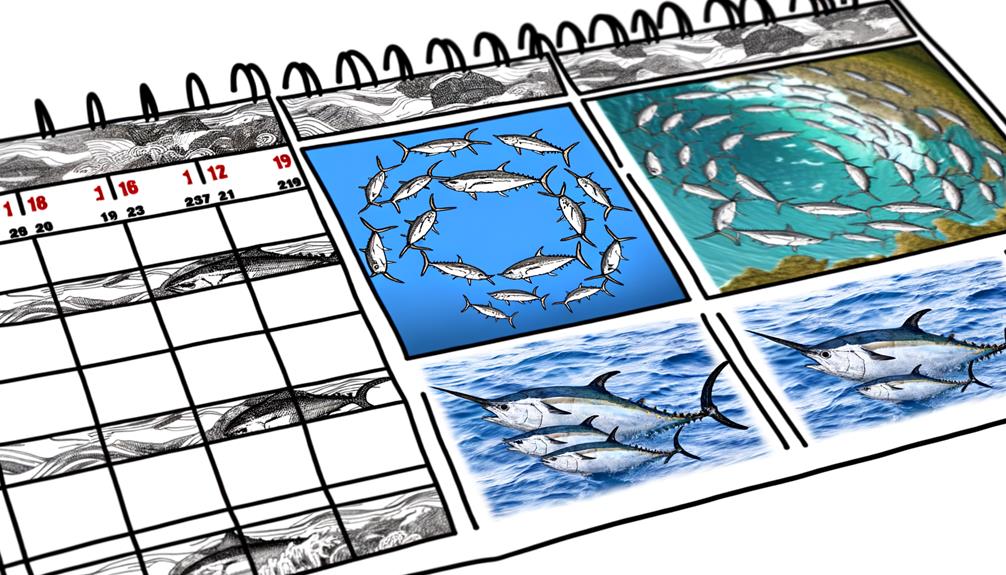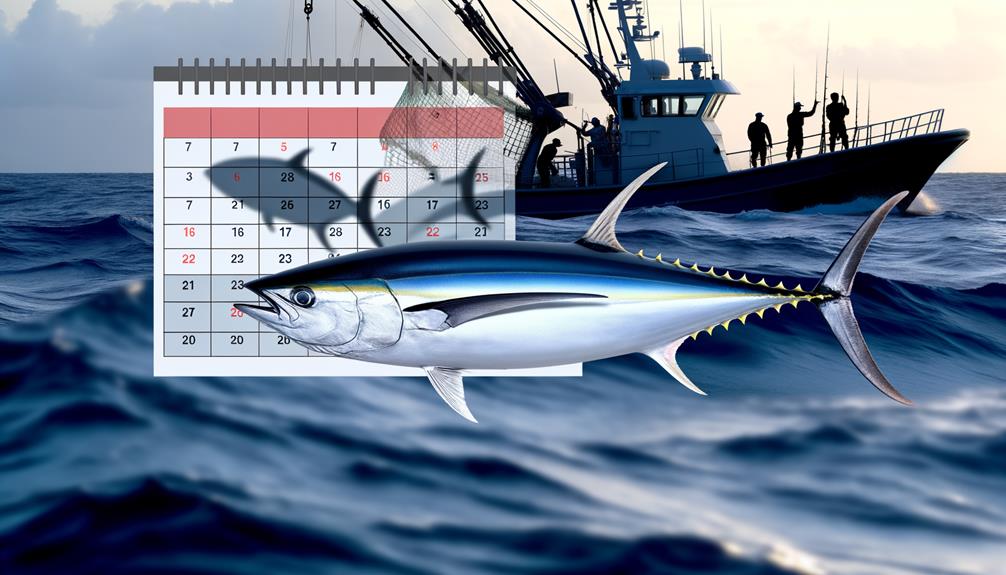Like a hidden gem beneath the ocean waves, the bluefin tuna season is a treasure that only reveals itself at certain times of the year. You've probably heard of this elusive period, but have you ever wondered about its exact duration?
Let's explore this topic together. We'll start by understanding that the length of the Bluefin tuna season can vary depending on several factors such as geographical location and environmental conditions. But just when does it start and when does it end? And why is it crucial to know this?
Hang tight, we're about to plunge into the fascinating world of Bluefin tuna fishing!
Key Takeaways
- The Bluefin tuna season in Maine and Massachusetts typically runs from June to November, but can be delayed by harsh winters and extended to December.
- August and September are considered the most fruitful months for catching Bluefin tuna in these areas.
- The duration of the Atlantic Bluefin tuna fishing season can vary depending on location, with warmer climates like Florida having no closed season.
- The Pacific Bluefin tuna season generally spans from May to October, with peak months for tuna fishing in California being from March to October.
Understanding Bluefin Tuna Season
To understand the seasonality of Bluefin tuna, it's crucial to note that the fishing season in Maine and Massachusetts typically kicks off in June and winds down in November, although harsh winters can push the start to July and, less commonly, extend it into December. This understanding of the Bluefin tuna season is vital for planning your fishing days.
You'll find that the most fruitful months to catch Bluefin tuna are generally August and September. However, don't be discouraged if you're planning a trip outside these months. The beauty of the Atlantic Bluefin Tuna lies in its unpredictability. Fishermen have reported successful catches throughout the season, indicating the broad window of opportunity.
This seasonality, shaped by the cycles of nature, is a testament to the resilience and adaptability of the Bluefin. When you're out on the water, rod in hand, remember that every part of the season holds potential. So whether you're donning your winter coat or summer hat, there's always a chance to engage in the exhilarating sport of Bluefin tuna fishing.
This is the essence of understanding Bluefin tuna season – it's about more than just the calendar months, it's about the thrill of the chase.
Atlantic Bluefin Tuna Season Duration
Depending on the location, the duration of the Atlantic Bluefin tuna fishing season can vary significantly, ranging from a few months to practically year-round. You'll find the Wicked Tuna Fishing Season, for instance, in Massachusetts and Maine, typically runs from June to November. However, the best months for tuna fishing in these areas are August and September.
The season lengths may also be influenced by weather conditions. In harsh winters, the season's start could be postponed to July, and it may extend into December. Conversely, in warmer climates like Florida, there's no closed season for bluefin tuna fishing, with the high season running from May to September.
In the Bahamas, the Atlantic Bluefin tuna season duration is shorter, lasting only from May to August, while in Boston, it's from June to October. The Outer Banks in North Carolina has its own unique season from January to March, and in Oregon, the season commences mid-July, ending mid-October.
Pacific Bluefin Tuna Season Overview

Shifting our focus to the Pacific Bluefin Tuna, the fishing season generally spans from May to October, although this can vary based on location and the species' annual migration patterns. This Pacific Bluefin Tuna season overview will give you a broader understanding of the best time to catch these magnificent fish.
Fishing regulations for the Pacific Bluefin Tuna cater to recreational anglers all year round on the Pacific coast, with bag limits set by each state. In California, for instance, the peak months for tuna fishing fall between March and October, with a daily limit of two fish per boat and an onboard maximum of 20.
However, bear in mind that the Pacific Bluefin Tuna is overfished, hence regulations may alter due to challenges in managing the population. This means the long each season lasts could be subject to change in the future.
For a cultural reference, consider the Wicked Tuna TV show. Its season runs for 14 weeks, releasing an episode every Sunday. This show underscores the intense competition and financial importance of the tuna fishing season.
Always remember, responsible fishing practices contribute to the sustainability of this incredible species.
Regional Variances in Tuna Seasons
While the Pacific Bluefin Tuna season offers a broad timeline for anglers, you'll find that the optimal fishing periods for this species can vary significantly across different regions. This is due to the regional variances in tuna seasons, which are influenced by factors like water temperatures and prey availability.
Below is a table showcasing the best times for tuna fishing in a selection of regions:
| Region | Tuna Species | Best Fishing Months |
|---|---|---|
| Maine, Massachusetts | Bluefin Tuna | August, September |
| The Bahamas | Yellowfin Tuna | May to August |
| Hawaii | Yellowfin Tuna | June, July, August |
However, it's essential to note that these periods can change annually. For example, federal regulations may establish specific Restricted-Fishing Days throughout the year, influencing how long are tuna fishing seasons. In 2023, these restrictions will occur from July 1 through November 30.
Impact of Regulations on Tuna Season

You'll find that regulations significantly shape the bluefin tuna fishing season, with rules like the Restricted-Fishing Days (RFD) schedule having a direct impact on when and how much tuna can be caught. In the United States, for instance, this strict schedule is in effect from July through November for the 2023 fishing year. This means that some days will be off-limits for commercial tuna fishing, with all rights reserved for the purpose of conserving tuna populations.
Different states also have varying seasons. In Maine and Massachusetts, the season typically starts in June and ends in November. However, the season will sometimes extend into December, especially if there was a harsh winter that delayed the start. Similarly, in the Bahamas, the tuna season spans just four months, from May through August.
The impact of these regulations is evident in the fishing practices across different regions. By setting specific RFDs and adjusting the season length based on weather conditions, regulatory bodies aim to ensure sustainable fishing, striking a crucial balance between commercial fishing interests and the long-term health of bluefin tuna populations.
Frequently Asked Questions
How Long Is the Bluefin Tuna Season on Wicked Tuna?
You're looking at six months for the bluefin tuna season on Wicked Tuna, typically from June to November, considering fishing regulations, catch quotas, tuna migration, season profitability, sustainability issues, and crew experiences.
How Long Is Bluefin Tuna Season in Gloucester?
In Gloucester, you'll find the bluefin tuna season typically spans from June to November. It's crucial to understand local regulations, seasonal patterns, fishing techniques, preferred bait, and the economic and environmental implications.
How Old Is a 500 Pound Tuna?
You're wondering about a 500-pound tuna's age, right? Well, considering tuna's growth patterns and diet, it's likely around 10-12 years old. Factors like weight and maturity age play crucial roles in this estimate.
How Long Is the Bluefin Tuna Season in the Us?
In the US, your bluefin tuna season typically starts in June and ends in November. It's influenced by factors like tuna migration, fishing regulations, and seasonal impacts, affecting both sustainability and economic implications.
Conclusion
In wrapping up, you've navigated the depth of bluefin tuna seasons. You've dived into the Atlantic and Pacific nuances and surfaced through regional variances.
You've weathered the storm of regulations that might tip your boat. So, despite Mother Nature's fickleness, you're well-equipped to reel in success throughout the season.
Just remember, in the dance of the bluefin, timing is everything. Happy fishing, and may your patience be as deep as the ocean!
